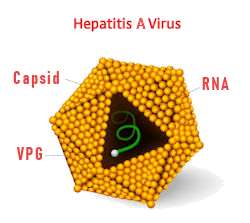Specific Bloodborne Pathogens
Hepatitis A Virus (HAV)
Hepatitis A is a vaccine-preventable liver infection caused by the hepatitis A virus (HAV).

HAV is found in the stool and blood of people who are infected. Hepatitis A is very contagious. It is spread when someone unknowingly ingests the virus — even in microscopic amounts — through close personal contact with an infected person or through eating contaminated food or drink.
Symptoms of hepatitis A can last up to 2 months and include fatigue, nausea, stomach pain, and jaundice. Most people with hepatitis A do not have long-lasting illness. The best way to prevent hepatitis A is to get vaccinated.
Complications of Hepatitis include cirrhosis (scarring) of the liver, liver cancer, and liver failure. There is no known cure for the hepatitis A virus, but most people make a full recovery. However, a very small proportion of people infected with hepatitis A could die from fulminant hepatitis.
Hepatitis A is transmitted through the fecal-oral route. This can happen through:
- Close person-to-person contact with an infected person
- Sexual contact with an infected person
- Ingestion of contaminated food or water
According to the CDC, in 2019, there were 2,958 reported cases of Hepatitis A. There was an increase of 850% from 2014 to 2018. This increase was primarily due to unprecedented person-to-person outbreaks reported in 24 states among people who use drugs and people experiencing homelessness.
Knowledge Check Choose the best answer for the question.
2-1. The increase in hepatitis A is primarily due to _____.
You forgot to answer the question!
